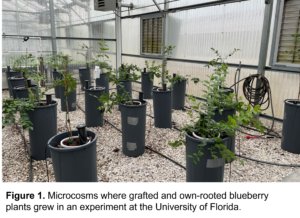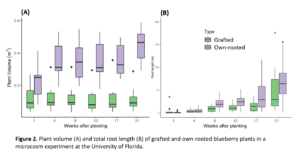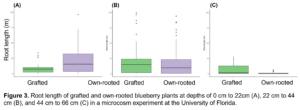Progress report for LS22-370
Project Information
There are over 28,000 acres of blueberry farms in the southeast. Something all these farms have in common is the extensive use of soil inputs. Growers use pine bark, large amounts of fertilizers, and large volumes of irrigation water to support agricultural production. These inputs increase blueberry establishment and production costs, reducing farm profitability and limiting who can grow blueberries in the southeast. Soil inputs also increase the likelihood of soil degradation, nutrient percolation, and water pollution. Reducing or eliminating the need for soil inputs is a critical step to increase the sustainability of blueberry farming systems in the southeast. Grafting blueberry on resilient rootstocks is an avenue to reduce the need for soil inputs, reduce establishment and production costs in blueberry farms, and broaden participation of underrepresented farmers in blueberry production. Previously, we have shown that commercial blueberry production targets can be attained with blueberry grafted on sparkleberry rootstocks. This project seeks to expand on earlier work by designing and testing a reduced input blueberry production system that uses less water, less soil amendments, and less fertilizers than blueberry farms in the southeast currently use. We will use participatory and multidisciplinary research methods to address sustainability across multiple dimensions. First, we will establish a grower advisory board and evaluate grafted blueberry plants in reduced input scenarios in a greenhouse trial. Then, we will conduct in-farm trials in Florida and Georgia where we will evaluate plant stress, agronomic productivity and soil health impacts. Additionally, we will quantify inputs and costs to conduct an investment analysis using data from the farm trials. This will allow us to assess the environmental and economic sustainability of reduced input blueberry farming. We will also seek to impact the social sustainability of blueberry farming through this project. We will utilize a multi-phased, data driven approach to promote adoption of the reduced input blueberry farming. We will work in collaboration with industry stakeholders, university faculty, and grassroots organizations to reach traditional and underrepresented growers. We will identify adoption gaps and information interests among growers. This will inform the design and delivery of educational materials and activities including multi-media products (videos, blog posts, articles, and social media), hands-on learning (field days for growers), and train-the-trainer workshops (regional in-service training for extension agents). We will evaluate the efficacy of educational and informational activities using surveys, follow-up interviews, and site visits to understand the extent of adoption. Ultimately, we expect the reduced input blueberry production system will 1) reduce reliance on practices that compromise soil health and water quality, 2) reduce establishment and production costs in blueberry farms, and 3) remove barriers for the participation of underrepresented groups in blueberry farming. These changes will move blueberry production systems towards environmental, economic, and social sustainability.
Our overall goal is to increase the sustainability of blueberry farming systems in the southeastern United States by leveraging the resilience of grafted blueberry plants. Specific goals include:
Objective 1: Develop input reduction thresholds for blueberry production
Objective 2: Design a reduced input production system that uses grafted blueberry plants
Objective 3: Evaluate reduced input blueberry production using agronomic productivity, environmental, and economic sustainability metrics
Objective 4: Increase adoption of the reduced input blueberry production system
Cooperators
Research
We constructed microcosms that imitate the blueberry production system in the southeastern U.S. (Figure 1). Microcosms consisted of a 70 cm by 40 cm container. The lower half of the container was filled with a well-drained Arendondo series soil collected from a blueberry farm. The top half of the container was filled fine pine bark. This stratification of the soil column represents the prevalent blueberry farming system in the region, where growers plant in raised beds made of pine bark that sit on top of native soil. We equipped is microcosm with drip irrigation according to commercial farming practices.
We planted grafted and own-rooted blueberry plants in these mesocosms. One year-old sparkleberry plants were side-grafted with scions of southern highbush blueberry cultivar ‘Sentinel’. One year-old ‘Sentinel’ plants were used as controls. ‘Sentinel’ is a new highbush blueberry variety that enjoys wide popularity among growers. Grower advisory board members Bert Sheffield and Kyle Straughn concurred with the cultivar selection.
We grew plants in the microcosms for 12 months. We used root observation tubes and a minirhizotron scanner to monitor root growth. We also used soil moisture, soil water potential, photosynthetically active radiation, temperature, and air relative humidity sensors to measure environmental conditions in the microcosms. We used RGB cameras and quantum sensors to measure plant size.

We validated mesocosm results in a field planting of grafted and own-rooted blueberry. This field is managed with a reduced-input approach. Mature 'Patrecia' southernhigbush blueberry plants were connected to stem psychrometers, infrared gas analyzers, and soil moisture sensors. Irrigation was lapsed for 3 days and plant responses to water deficit were observed before (acclimation period), during, and after (rehydration period) stress.
We connected with growers from Georgia and Florida. They indicated that 'Farthing' and 'Sentinel' southern highbush blueberry scions would be attractive for the field plantings in their farms. We grafted these scions onto clonal sparkleberry rootstocks during the fall of 2023. Since then, we have pruned and trained these plants (100 plants in total) in preparation for summer 2024 field planting. We have communicated with the growers and established input reduction goals (less water, less pine bark, less nitrogen fertilization). The most feasible way to accomplish this is to reduce the number of drip lines in the bed from 2 to 1 (in Florida) or to increase the emitter spacing in the drip line from one emitter every 12 inches to one emitter every 18 inches (in Georgia). Growers are currently implementing these changes in their farm and we are on track for June 2024 planting. Soil health data collection and leaf nutrient levels data collection will start during the weeks prior to planting once the plots are established.
Edaphic and environmental conditions in the microcosms closely resembled blueberry farms and promoted vigorous plant growth. Own-rooted plants exhibited larger canopies than grafted plants (Figure 2A). This is consistent with the long establishment period of grafted plants in field conditions (Heller et al. 2023). Own-rooted plants also exhibited larger root systems (Figure 2B). However, there were notable differences in root distribution between grafted and own-rooted plants. Own-rooted plants exhibited higher root length than grafted plants in the first 22 cm of the soil profile (Figure 3A). There were no differences at depths between 22 cm and 44 cm (Figure 3B). Grafted plants exhibited higher root length than own-rooted plants at depths higher than 44 cm (Figure 3C). These results confirm field observations that suggested there could be contrasting root architecture between sparkleberry and blueberry (Lyrene 1997). Deeper roots in grafted plants might be an asset to promote reductions in irrigation and fertilizer use.


We found additional evidence of the resilience of grafted blueberry plants in the field validation experiment. When subjected to water deficit, six-year old grafted plants maintained their midday photosynthetic rates. In contrast, own rooted plants exhibited declining photosynthetic rates when challenged with water deficit. Grafted plant net photosynthesis was greater than 5 μmol/m2/s during the stress period, whereas own-rooted plants were as low as zero μmol/m2/s. Resilience was also documented during rehydration. Grafted plants maintained their photosynthetic rates, but own-rooted plants did not recover up to 3 days after rehydration.
Stem water potential data helped put gas exchange results in context. Stem water potentials are negative magnitudes that measure the water status of the plant (the more negative a number the worse the hydration status of the plant). Midday stem water potentials of grafted plants were higher than those of own-rooted plants during the acclimation, water deficit, and rehydration periods.
Altogether, these results indicate that grafted blueberry plants avoid water deficit stress -likely due to their deep root systems.
Educational & Outreach Activities
Participation summary:
We made a presentation at the 2022 Annual Meeting of the American Society for Horticultural Science. This is the flagship scientific meeting of the horticulture industry. We also hosted a group growers, extension educators, and industry professionals as part of the 2023 Spring Field Day of the Florida Blueberry Growers Association.
We made a presentation at the Spring Field day of the Florida Blueberry Growers' Association in Citra, FL in March 2024. This meeting brings together growers, extension agents, and other industry professionals from the blueberry industry. We presented results from the field validation experiment here.
We recorded an instructional video about grafting techniques for grafted blueberry liner production with the assistance of the UF/IFAS Communications office. The video is currently in the post-production stage. We expect to publish this video in the summer of 2024.
Project Outcomes
The graduate student working on this project was awarded the 2022 Grant A. Harris fellowship ($10,000 in instrumentation) to augment her work in the microcosm experiment.